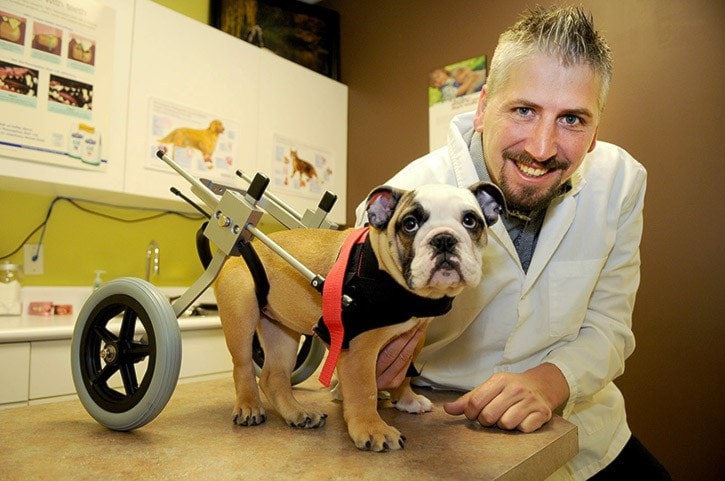Lily Longtail wanders from room to room at Cottonwood Veterinary Clinic. She gets treats in one room, and pats in another.
She is a 13-week-old English bulldog with a tan-coloured body and soft, white face. Her ears perk up and her head tilts to the side when she hears the word "cookie".
Lily may sound like a typical puppy, but she's not.
A little more than a month ago, when she was only eight weeks old, Lily became acutely paralyzed and had great difficulty moving her hind legs. She had no control over her bladder and bowel movements, and she could barely wag her tail. No one knew how or why this happened to the young dog.
Her owner ended up signing Lily over to the clinic.
Dr. Tim Maarhuis and the staff had a few options. They could either: A) do a post-mortem diagnosis; B) spend thousands of dollars to do an MRI on her with no guarantee that the results would confirm what was wrong; or C) buy her a canine cart.
Euthanizing her was not an option, so they went online to dogwheelchairscenter.com and bought her a cart for less than $200.
"It was an unfortunate situation and we found that this was best for Lily," says Dr. Maarhuis. "You don't have to euthanize just because the animal is paralyzed."
Lily's cart is mainly powered by her front legs, but it is designed for her to use and strengthen her hind legs. Each back leg is put through a padded ring which sits at just the right height for her hind paws to comfortably and properly touch the ground. The cart is secured to Lily with a vest that is wrapped around her chest. The cart can be adjusted as she grows, but she will need a new one by the time she's full-grown.
She's had the cart for about three weeks and Dr. Maarhuis has already seen an improvement in her back legs. Although she still moves slowly while in the cart, it is easy to see that Lily is trying her best to walk with her hind legs in sync with her front. He points out that her right hind leg is stronger than her left.
Surprisingly, Lily actually moves more quickly when not in her cart by pulling herself around and dragging her hind legs. She can pull herself into her crate at the clinic and she even has enough muscle strength in her back legs to move her whole body into her bed and curl up.
Even though that's not how the staff at Cottonwood Veterinary Clinic want to see her move around, it's sometimes difficult to get Lily to cooperate.
Bulldogs are a laid-back breed to begin with, so getting Lily to walk around in her cart as much as possible when she is strapped into it is a bit of a challenge, says Julie Maarhuis, clinic manager and wife of Dr. Maarhuis.
It is also a lot of work for the little puppy, she adds. It's physically tiring for her and she often just stands still waiting for someone to take her out of her cart, but that doesn't always happen. In order for her to build muscle memory, Lily needs to be in the cart and be mobile for a minimum of three hours a day.
She's slowly learning how to manoeuvre in it. At first she would bump into doorways, not used to the wheels on either side and the extra width around her. Now, she clears doorways and can even run when she wants to — like when she's at home in the evenings with the Maarhuis family chasing their dogs around the house.
Although canine carts and doggy wheelchairs may sound foreign to many people, they've actually been around for more than 50 years.
They're not only used for animals with some form of paralysis, but also for those with amputations, severe arthritis, bone cancer, and to rehabilitate pets who have been injured.
Dr. Maarhuis doesn't know exactly how Lily was acutely paralyzed, or if she'll ever walk unaided again. Fortunately, since she's young there is a chance that she can regenerate the muscle memory. Everyone at the clinic is hoping for that in the end, but right now their goal is to be able to take her outside for regular walks.
In the meantime, people coming into the clinic continue to ask questions about little Lily Longtail and her cart.
"It's a good educational tool for our clients — to teach them that animals can live a happy and health live," says Julie Maarhuis.
